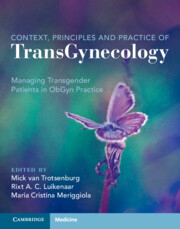Book contents
- Context, Principles, and Practice of Transgynecology
- Context, Principles, and Practice of Transgynecology
- Copyright page
- Dedication
- Contents
- Foreword
- Preface
- Contributors
- Abbreviations
- Section A Contextual Transgynecology
- Chapter 1 Terminology in Transgender Medicine
- Chapter 2 Optimizing Clinical Ob/Gyn Services through Improved Communication with Trans Persons
- Chapter 3 What Do Trans People Expect from Transition and What Do They Encounter Physically?
- Chapter 4 A Pondering Trans Female Gynecologist
- Chapter 5 The Ever-changing Role of the Mental Health Care Professional in Transgender Healthcare
- Chapter 6 Impact of Stigma and Resilience on the Health of Transgender and Nonbinary People
- Chapter 7 Dealing with Health Needs and Physical Complaints of Nonbinary Clients
- Chapter 8 Gender is So Much More: Impulses for a Gender-variant Gynecological Expertise from a Queer-theoretical Perspective
- Section B Practicing Transgynecology
- Section C Gynecological Surgery for Transgender Males
- Section D Sexuality and Contraception
- Section E Fertility and Reproduction
- Section F Impact of Gender-affirming Hormonal Therapy on Genital Organs
- Section G Screening and Prophylaxis
- Transgynecology Index
- References
Chapter 8 - Gender is So Much More: Impulses for a Gender-variant Gynecological Expertise from a Queer-theoretical Perspective
from Section A - Contextual Transgynecology
Published online by Cambridge University Press: 22 December 2022
- Context, Principles, and Practice of Transgynecology
- Context, Principles, and Practice of Transgynecology
- Copyright page
- Dedication
- Contents
- Foreword
- Preface
- Contributors
- Abbreviations
- Section A Contextual Transgynecology
- Chapter 1 Terminology in Transgender Medicine
- Chapter 2 Optimizing Clinical Ob/Gyn Services through Improved Communication with Trans Persons
- Chapter 3 What Do Trans People Expect from Transition and What Do They Encounter Physically?
- Chapter 4 A Pondering Trans Female Gynecologist
- Chapter 5 The Ever-changing Role of the Mental Health Care Professional in Transgender Healthcare
- Chapter 6 Impact of Stigma and Resilience on the Health of Transgender and Nonbinary People
- Chapter 7 Dealing with Health Needs and Physical Complaints of Nonbinary Clients
- Chapter 8 Gender is So Much More: Impulses for a Gender-variant Gynecological Expertise from a Queer-theoretical Perspective
- Section B Practicing Transgynecology
- Section C Gynecological Surgery for Transgender Males
- Section D Sexuality and Contraception
- Section E Fertility and Reproduction
- Section F Impact of Gender-affirming Hormonal Therapy on Genital Organs
- Section G Screening and Prophylaxis
- Transgynecology Index
- References
Summary
To understand the vastness of gender self-definitions, one needs to detach oneself from the influence of the body on one’s perception of gender, as every gender identity – as well as every gendered body, for that matter – is unique. Gender identity is formed via an individual biopsychosocial developmental process that involves countless variables. Our diverse cultures are currently developing (or re-discovering) – with greater or lesser degrees of commitment – the idea that gender identity goes far beyond sexual organs. This realization calls for a rethinking of all medical disciplines that deal with the body and gender. One of these fields is gynecology, which has a prominent responsibility in this reassessment, particularly in its function as the medical provider of gender confirmation procedures. With gender diversity now being increasingly recognized, the future responsibilities of gynecology will go beyond the traditional concepts of femininity or masculinity.
Information
- Type
- Chapter
- Information
- Context, Principles and Practice of TransGynecologyManaging Transgender Patients in ObGyn Practice, pp. 56 - 65Publisher: Cambridge University PressPrint publication year: 2022
